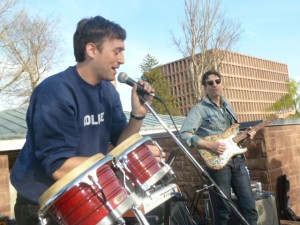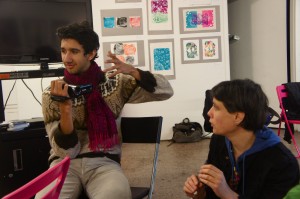Sarah Wolfe ’12 reflects on “The Big Draw: Middletown”, a public art event hosted by the Friends of the Davison Art Center.
In celebration of its 50th anniversary, the Friends of the Davison Art Center put together The Big Draw: Middletown this past Sunday. The event was intended to celebrate the art of drawing in its many forms and was a unique opportunity for drawers of all ages and skill levels to try their hand at different techniques for free!

I had the pleasure of being a member of the student staff for the event. Tired and unhappy about the wet and dreary weather, I trudged over to the Davison Art Center Sunday morning to learn exactly what I would be doing. My attitude almost immediately improved as I watched about 15 Middletown High School students parade around the historic rooms of Davison dressed in costumes ranging from My Fair Lady to Pride and Prejudice to Kiss Me, Kate! That particular workshop, called “Tableaux Vivants” was organized by the students, who were members of the Middletown High School Art Club, provided an opportunity for participants to draw the costumed students in their historic setting.
I was placed at the Earth Day Collaborative Mural Project station. Stationed in the Art Workshops Lobby, I watched drawers aged 3 to 40 come and contribute a drawing of what they thought represented Earth Day on a huge piece of white paper on the wall. (“Go ahead, kids, you can actually draw on the walls today!”) The drawing skills ranged widely, as did the subject matter, the attention span, and the colors used. But by the end of the day, all of the staff was impressed by the beauty of what had been created with so many hands.

Nearby was the Scavenger Hunt, one of the activities that would have benefited from warmer, dryer weather. However, many families and students picked up a booklet to save for a later day. The hunt, entirely student designed, was a booklet of twelve different drawing challenges, ranging from: “Find a surface in nature with texture. What does it feel like? Make a rubbing of it by placing this page over and rubbing the side of your pencil on top” to “Draw a tree or a flower you see without looking at your page and without lifting your pencil.” Though there were some young boys who were disappointed with the lack of prizes involved with this particular scavenger hunt, most participants were excited to save it for a day they could do it outside.
Down the hall from where I was stationed was the Model Marathon, where supplies and a nude model were provided for participants to do some figure drawing. This was one of the most popular workshops in the event as it was a phenomenal opportunity for practice figure drawing without having to pay for a class.
These were only four of the ten workshops that were available for free to anyone who came and registered. Despite the grey weather, the turnout was good, and it was wonderful to see such a mix of Wesleyan students and outside community members participating in the joy of putting pencil/charcoal/marker to paper. There are plans to continue and grow the event, and I hope to see it become even more popular in the years to come.












